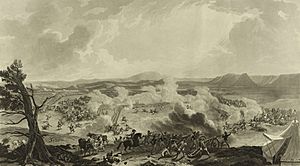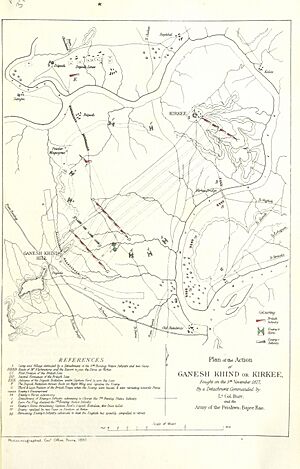Battle of Khadki facts for kids
Quick facts for kids Battle of Khadki |
|||||||||
|---|---|---|---|---|---|---|---|---|---|
| Part of the Third Anglo-Maratha War | |||||||||
 |
|||||||||
|
|||||||||
| Belligerents | |||||||||
| Commanders and leaders | |||||||||
| Bapu Gokhale | Lt. Col. Burr Captain Ford |
||||||||
| Strength | |||||||||
| 28,000 | 3,000 | ||||||||
| Casualties and losses | |||||||||
| 500 | 86 | ||||||||
The Battle of Khadki, also called the Battle of Ganeshkhind, happened in Khadki, India. It took place on November 5, 1817. This important battle was fought between the British East India Company and the Maratha Empire. The British forces won a big victory. After the battle, Khadki became a military base for the British.
Contents
Why the Battle Happened
The Maratha Empire's Troubles
The Second Anglo-Maratha War was very bad for the Maratha Empire. After this war, the empire started to become weaker. The leaders, called Peshwas and Sardars, had less control. They also had many financial problems.
A strong Maratha leader named Mahadji Scindia had made the empire powerful again in northern India. He used his cavalry and French-trained soldiers. Mahadji even defeated the British in the First Anglo-Maratha War. But after he died in 1794, the Maratha leaders found it hard to fight the British. The empire kept getting weaker.
Who Fought in the Battle?
The Maratha Army
The Maratha Army was led by Bapu Gokhale. He had many other generals helping him. These generals, called sardars, were like dukes or earls. They had both cavalry (soldiers on horses) and infantry (soldiers on foot). The Maratha army also had cannons, led by Laxmanrao Panshe.
The British East India Company Army
The East India Company's army was led by Colonel Burr and Captain Ford. Colonel Burr marched to Khadki on November 1st. Captain Ford arrived on November 4th.
How Many Soldiers?
The Maratha army was much larger. They had about 28,000 soldiers. This included 20,000 cavalry and 8,000 infantry. They also had 20 cannons.
The British force was much smaller. They had only about 3,000 soldiers. This included 2,000 cavalry and 1,000 infantry. They had 8 cannons.
The Battle Begins
Colonel Burr's soldiers came from Dapodi village. This village was near where the Pavana and Mula rivers meet. His soldiers were in Pune to protect the Peshwa, the Maratha chief minister.
Before the battle, a Maratha commander tried to get Captain Ford to switch sides. But Captain Ford refused.
First, Maratha soldiers fired cannons at the British Resident's house. The Resident was a British official named Mr. Elphinstone. After he left, Maratha cavalry burned all the British houses nearby. Mr. Elphinstone joined the British troops in Khadki.
Colonel Burr was told to advance. He met Captain Ford's soldiers, and they moved forward together. The Maratha soldiers were surprised. They thought the British would be scared or bribed. The Maratha army began to lose hope.
Bapu Gokhale rode around, trying to encourage his soldiers. He ordered his cavalry to attack and try to surround the British. Some British soldiers got separated from their main group. Gokhale saw this chance and charged with 6,000 chosen horsemen.
Colonel Burr saw the attack. He told his men to stand strong and hold their fire. The cavalry charge did not work well. The Maratha horses got stuck in a muddy area in front of the British. As the horses struggled, the British soldiers fired at them. Many Maratha soldiers were killed. Only a few Maratha horses reached the British lines. The rest turned back or ran away.
The failure of this big cavalry charge upset the Marathas. They started to move their cannons away. Their infantry also retreated. When the British soldiers advanced, the battlefield was cleared.
The next morning, more British soldiers arrived. This stopped Gokhale from attacking again. The British lost 68 soldiers. The Marathas lost about 500 soldiers, killed or wounded.
What Happened After the Battle?
After Khadki, a few more battles were fought. The British fought against other Maratha groups. The Peshwa, the main Maratha leader, was defeated in another battle near Asirgarh.
Later, the British tricked some of Sardar Yashwant Ghorpade's Maratha forces with bribes. This allowed more British soldiers to join the fight. The Peshwa had to flee Pune. The British East India Company took over the Shaniwar Wada, the Peshwa's palace, on November 17, 1817. By 1818, the Peshwa had given up to the British East India Company.
The Battlefield Today
After the battle, the British troops crossed a river at a place called Yelloura ford. We don't know exactly where this was. Some people think it might be where the Bund Garden is today. "Yelloura" might be an old name for today's Yerwada. This fits with a hill mentioned in old records.
The muddy area that helped the British is also not known today. It might have been in the Range Hills Colony or near the Symbiosis Institute of Management. The word "morass" can also mean a difficult situation. So, it might describe the confused state of the Maratha charge.
A historian named Grant Duff wrote about the battle. He watched it from the hills of Bhamburda. This spot was probably on the hill behind today's Hanuman Nagar or Pandav Nagar.


